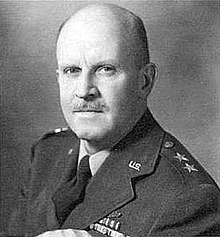Gordon P. Saville
| Gordon Philip Saville | |
|---|---|

Major General Gordon Philip Saville
|
|
| Born |
September 14, 1902 Macon, Georgia |
| Died | January 31, 1984 (aged 81) Lackland Air Force Base |
| Allegiance |
|
| Service/branch |
|
| Years of service | 1923–1951 |
| Rank |
|
| Commands held |
XII Fighter Command First Tactical Air Force III Tactical Air Command Air Defense Command |
| Battles/wars | World War II |
| Awards |
Distinguished Flying Cross Distinguished Service Medal (2) Bronze Star Medal Legion of Merit Air Medal |
Gordon Philip Saville (September 14, 1902 – January 31, 1984) was a United States Air Force major general who was the top authority on US air defense from 1940 to 1951. Blunt and direct in manner, Saville had been an outspoken proponent of tactical aviation in the 1930s against a brotherhood of airmen who promoted strategic bombing.
Saville succeeded Claire L. Chennault as America's leading fighter aircraft tactician. With Benjamin S. Kelsey, Saville co-wrote the technical specifications which led to the Lockheed P-38 Lightning and the Bell P-39 Airacobra fighters. In 1949 he selected the North American F-86 Sabre as America's main defense fighter, and in 1950 he approved a guided air-to-air missile system that would be carried aboard the proposed supersonic 1954 interceptor; the missile produced was the AIM-4 Falcon.
Saville was a technical and scientific-minded leader who helped pioneer advanced mathematics for operations research, and computer systems for centralized coordination of air defense. He advocated the expansion of radar installations to create an unbroken air defense network. He explored the concept of a military aircraft designed around an integrated electronics fire-control system built by various subcontractors. After retiring from the military, Saville worked in the defense industry.
Gordon Philip Saville was born in Macon, Georgia, on September 14, 1902. His Regular Army officer father propelled Saville's older brother to enroll at the United States Military Academy at West Point, and he urged Saville to accept an appointment to the United States Naval Academy. However, Saville wanted to fly so he rejected formal military schools. Instead, he attended the University of Washington, Antioch College, and then the University of California and was commissioned a second lieutenant in the United States Army Reserve on November 5, 1923, in the infantry, seeing active duty in August 1924 and August 1925. While on reserve duty at Crissy Field in San Francisco, Saville watched Army Air Service pilots training on military aircraft. He determined that he would join them or leave the military.
...
Wikipedia
